|
"Lo and behold,
here was Blom's colossal head that we had almost given up hope of
locating."--------1940,
Matthew W. Stirling, "Great Stone Faces Of The Mexican Jungle,"
National Geographic, September 1940, p. 328.
"Hallmark of the
Olmec: colossal heads were unknown until 1862, when a Mexican scholar
saw a head found at Tres Zapotes (Veracruz, Mexico)."--------1993,
George E. Stuart, "New Light On The Olmec," National
Geographic, November 1993 p. 94.
"It has been
proposed that the colossal heads represent portraits of individuals at
the apex of power at the Olmec centers such as San Lorenzo Tenochtitlan
and La Venta."------2010,
Roberto Lunagomez Reyes, "Plates," Olmec, Colossal
Masterworks Of Ancient Mexico,
p. 122.
"Both the
Olmec and the Aztecs depicted human heads as complete sculptures carved
in the round---. Although the Aztecs created relatively few
three-dimensional heads isolated from their torsos."--------2010,
Richard A. Diehl, "The Olmec Legacy In Stone: A Mesoamerican Alpha
And Omega," Olmec, Colossal Masterworks Of Ancient Mexico,
p. 81.
"At
its height (Olmec culture)
some of the most magnificent and awe-inspiring sculptures ever
discovered in Mexico were fashioned without the benefit of metal tools."----1994,
Michael D. Coe, "Mexico, From The Olmec To The Aztecs," p. 66.
"The Early Preclassic sculptures of San Lorenzo
include eight Colossal Heads of great distinction. These are up to 9
feet 4 inches (2.85 m) in height and weigh many tons."---------1994,
Michael D. Coe, "Mexico, From The Olmec To The Aztecs," p. 68.
"The colossal
heads provenienced from San Lorenzo, Tres Zapotes, Corbata, and La Venta
sites appear to be the earliest form of portraiture for prominent
leaders or their elite lineages recorded in Mesoamerica"---------2010,
Susan Toby Evans and David L. Webster, "Archaeology Of Ancient
Mexico And Central America An Encyclopedia," p. 34.
"The material
remains of Olmec civilization are recognized as some of the finest "high
art styles" to be found anywhere in pre-Columbian America"---------1996,
Brian M. Fagan, "The Oxford Companion To Archaeology," p. 538.
"The Olmec
chose to work stone of the greatest hardness: basalt and andesite for
large monoliths, and jade and serpentine for small pieces."--------2010,
Sara Ladron de Guevara, "Olmec Art: Essence, Presence, Influence,
And Transcendence," Olmec, Colossal Masterworks Of Ancient
Mexico,
p. 81.

COLOSSAL HEADS OF THE OLMEC
VERACRUZ & TABASCO, MEXICO
PRECLASSIC PERIOD
The Olmec were master carvers of stone. The
colossal heads of the Olmec are the most recognizable symbol of the
Olmec civilization. It's obvious why writers often use the word colossal
to describe them. Their large size and strong features project an aura
of strength and power. Ever since the first one was discovered in 1862
at Tres Zapotes the expressive nature of these large monuments have
inspired the imagination of people around the world. Michael D. Coe
wrote in 1994, "At
its height some of the most magnificent and awe-inspiring sculptures ever
discovered in Mexico were fashioned without the benefit of metal tools." |
|
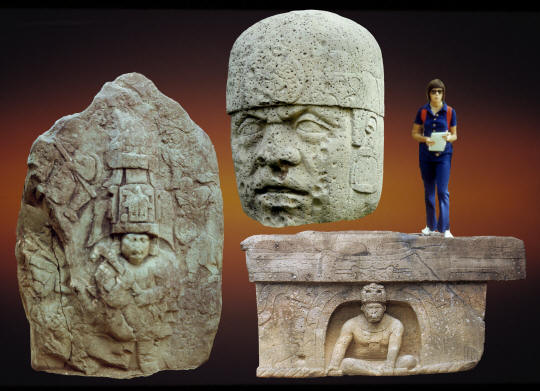
IMAGES FROM LITHIC CASTING LAB'S COLLECTION OF ORIGINAL IMAGES
CLICK ON PICTURE FOR LARGER IMAGE
MASSIVE OLMEC STONE WORK
LA VENTA & SAN LORENZO SITES
TABASCO & VERACRUZ, MEXICO
The Olmec culture produced very large
stone monuments in the form of stelae, thrones, and colossal heads.
The reason so many have survived so well is because they were made
from very hard basalt and andesite stone. They were made with simple
stone tools in very much the same way a common axe was made by
pecking and grinding, but only on a much larger scale. The surfaces
were shaped with stone hammers and smoothed by grinding. The people
on Easter Island made their large moai statues in the same way.
Neither culture had metal tools.
This picture shows three different types of large Olmec monolithic
stone sculptures. The stela on the left measures approximately 11
feet 5 inches (3.49 m) high and is made of basalt. The main figure
wears an elaborate headdress and is described as an Olmec ruler who
is dressed as a ballplayer. He is surrounded by "smaller beings."
The throne to the right measures 5 feet 3 inches (1.6 m) high and
it's made of basalt. These large stone monuments are often referred
to as alters but they are now identified as thrones. This throne was
discovered on the La Venta site. The figure in front is an image of
a ruler who seems to be emerging from a cave. He holds a long rope
that extends along the front and around the sides and on one side
the rope ends at the wrist of a possible captive. The large colossal
head was found on the San Lorenzo site in Veracruz. The figure is well proportioned
and is wearing a classic "football" style helmet. There does seem to
be some damage, particularly around the lips, and the surface is
considerably pockmarked. An estimated height is 8.8 feet (2.68 m)
high. |
|
|
The heartland of the Olmec culture developed in the southern
Gulf Coast plains of Mexico in the states of Tabasco and Veracruz.
Large stone monuments of various types have been found on approximately two dozen sites in this
region. The sites of San Lorenzo, La Venta, Tres Zapotes and, Laguna de
los Cerros were four of the most important centers of Olmec
society. Olmec was once considered to be the "mother-culture" of
Mesoamerica but that status is now generally rejected for a more
sophisticated notion that other areas were also developing equally
complex organized societies. The Olmec culture lasted for about a
thousand years. The defining traits of the Olmec develops between 1800
B.C. and 1400 B.C. The Olmec culture is in its decline by 400 B.C. Most
of the colossal heads were produced sometime between 1200 B.C. and 900
B.C. during the Preclassic Period. |
|
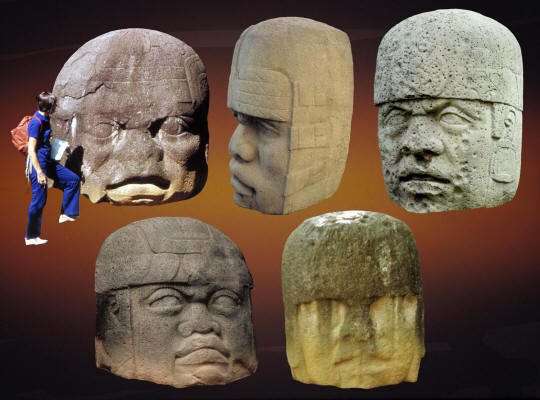
IMAGES FROM LITHIC CASTING LAB'S COLLECTION OF ORIGINAL IMAGES
CLICK ON PICTURE FOR LARGER IMAGE
COLOSSAL HEADS
OLMEC CULTURE
TABASCO & VERACRUZ, MEXICO
The colossal heads of the
Olmec are impressive. They are the most recognizable symbol of the Olmec
civilization. Their large size and strong features project qualities of
strength and power. They are believed to be individualized portraits of
important rulers. Each one wears a different helmet-like head covering
that have been referred to as ballplayer's helmets. The first colossal
head was discovered in 1862 when a Mexican scholar reported one found at
Tres Zapotes in Tabasco.
Colossal heads have facial features that appear to be
African. But the majority of academic scholars reject this possibility.
It's been suggested that the features may be more Asian than African. In
addition to the broad noses and thick lips some writers add the Asian
eye fold and straight hair that can be observed on naturalistic Olmec
sculptures. All of these traits can be observed in modern society Native
American Indians in the region today. DNA analysis has also not shown
any evidence of an African connection. There is also no evidence of
imports
from Africa, such as, plants, animals, materials or techniques.
Seventeen colossal heads have been discovered so far in the
Olmec heartland, where the states of Veracruz and Tabasco meet in the
tropical coastal plain of southern Mexico. Ten of the heads have been
recovered from the site of San Lorenzo Tenochtitlan in Veracruz. Two
have been found at Tres Zapotes, Veracruz one at Rancho la Cobata,
Veracruz, and four at La Venta, Tabasco. They range in size from 4.82
feet (1.47 m) high at Tres Zapotes to 11.15 feet (3.4 m) at Rancho la
Cobata. It's estimated that the largest heads weigh between 25 and 55
tons.
The five colossal heads in this picture were discovered on
two different sites. The example at top left and the two in the lower
row were found at La Venta. The two at top right were
found at San Lorenzo. The top center head measures 6 feet 1 1/4 inches (1.86 m) high.
All five examples are made of basalt. |
|
|
There are no identifying names on the Olmec
colossal heads. But scholars believe the sculpted heads represent
individualized portraits of important rulers or high status individuals.
They are so well done that precise elements, in the form of wrinkles,
frowns, and proportion, make it possible to identify individuals. These
portraits in stone also represent the beginning of the cult of the
ruler. A fundamental idea that spreads throughout later cultures in
Mesoamerica in which the rulers become legitimized within a sacred and
supernatural line of descent. |
|
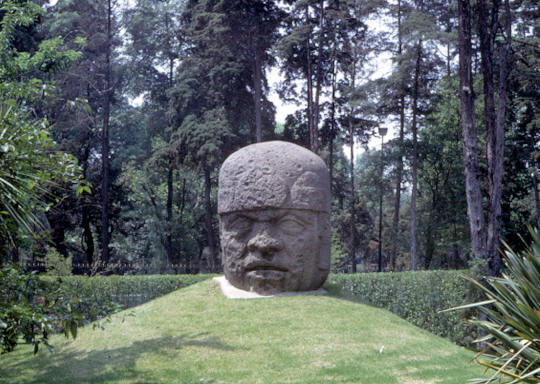
IMAGE FROM LITHIC CASTING LAB'S COLLECTION OF ORIGINAL IMAGES
CLICK ON PICTURE FOR LARGER IMAGE
COLOSSAL HEAD
OLMEC CULTURE
SAN LORENZO SITE
VERACRUZ, MEXICO
This large colossal head
was found on the San Lorenzo site in 1945 by Mathew Stirling's guide.
It's known as either San Lorenzo colossal head 2 or San Lorenzo monument
2. It was excavated in 1946 by Matthew Stirling. The head was laying on
its back. The figure is well proportioned and is wearing a classic
"football" style helmet that is engraved with three birds heads. There
does seem to be some damage,
particularly around the lips, and the surface is considerably
pockmarked. It's made of basalt and it measures 8.8 feet (2.68 m) high.
Its weight is estimated to be 20 tons. |
|
|
Seventeen colossal heads have been discovered so far.
Most of them were found at San Lorenzo. One is reported from Rancho la
Cobata in Veracruz, two from Tres Zapotes also in Veracruz, four from La
Venta in Tabasco, and ten from San Lorenzo in Veracruz. Although they
all represent different people, there are some similarities. They all
wear a helmet-like head covering that is often described as a ballplayer's
helmet. Each helmet has a different design pattern or insignia. Most of
them are geometric shapes but some are represented as animal parts of
birds or jaguars. The largest colossal head from Rancho la Cobata has
human hands on its helmet. The other similarity between the colossal
heads are the facial features of thick fleshy lips and broad flat noses. |
|
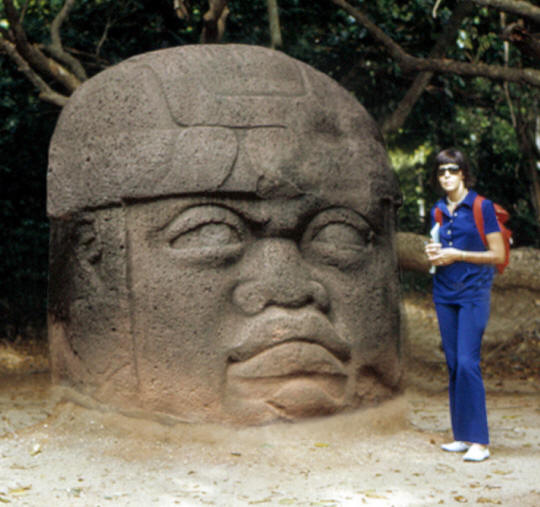
IMAGE FROM LITHIC CASTING LAB'S COLLECTION OF ORIGINAL IMAGES
CLICK PICTURE FOR LARGER IMAGE
COLOSSAL HEAD
OLMEC CULTURE
LA VENTA SITE
TABASCO, MEXICO
Designated as monument 1
this is the largest of four
colossal heads that were found on the La Venta site. It's also described
as the best preserved. This colossal head was first described in 1925 by
Franz Blom and Oliver La Farge while it was still half buried and later
fully excavated in 1940 by Matthew Stirling. The front of the "helmet"
is decorated with three designs that may be either claws or fangs of an
animal. Straps extend down both sides in front of the ears and both ears
have large ornaments that hang down from the earlobes. This colossal
statue is made of basalt
and has an estimated size of 8 feet 1 inch (2.46 m) high and weighs 24
tons.
Stirling describes his rediscovery of this colossal head in
1940: "Lo and behold, here was Blom's colossal head that we had almost
given up hope of locating! The eyes were completely covered (with
vines) and it was unrecognizable as
part of a head---. The colossal head exceeded our best expectations. It
proved to be a good two feet higher than the colossal head of Tres
Zapotes, which is about six feet in height." |
|
|
Olmec craftsmen used basalt and andesite to make their
largest monuments. All of the colossal heads are made of basalt. Olmec
craftsmen also used other very hard stones, in the form of jade and
serpentine, to make smaller items. The hardness of these materials is a
testament to the level of skill that was developing among stone
craftsmen during this early period in North America. Brian Fagan writes,
"The material remains of Olmec civilization are recognized as some of
the finest "high art styles" to be found anywhere in pre-Columbian
America." |
|
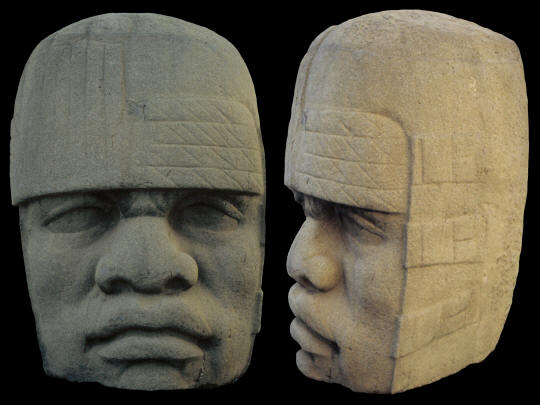
IMAGE FROM LITHIC CASTING LAB'S COLLECTION OF ORIGINAL IMAGES
CLICK ON PICTURE FOR LARGER IMAGE
COLOSSAL HEAD
OLMEC CULTURE
SAN LORENZO SITE
VERACRUZ, MEXICO
One art historian describes
this colossal head as "the most harmoniously proportioned of the
seventeen colossal heads that have been found to date." It's also one of
the best preserved examples. It was discovered in 1946 excavations by
Matthew W. Stirling in deep jungle on the San Lorenzo site 600 yards
(548.6 m) from the primary mound. The back of the sculpture has 26
circular depressions and three grooves that may have a ritual
connection. The top of the head and all of the right side is covered by
a helmet-like headdress that is described as having rods and cords
hanging down the front and other design features. The right ear is
visible. This is one of the smaller sculpted heads from San Lorenzo and
is designated as monument 4.
It's made of basalt and measures 6 feet 1 1/4 inches (1.86 m) high. |
|
|
The source of the stone that was used to make the colossal
heads came from the Sierra de los Tuxlas mountains in Veracruz. The
stone is described as a course grained dark grey basalt called Cerro
Cintepec. The stone didn't need to be quarried. There was a good supply
of this material in the form of natural spherical boulders that washed down the mountain sides in mud slides. Some of the
stones were transported a considerable distance, as far as 93 miles (149
kilometers). The colossal heads weigh from 6 to 40 tons and range in
size from 4.82 feet (1.47 m) to 11.15 feet (3.4 m) high so the effort to
move them would have been considerable. It's believed they were
transported, without the use of wheels, over causeways, ramps, roads and
some of them in barges over water. As an example of the size of some of
these large stones, Stirling wrote in 1940 about a large stela at La
Venta: "The next day, since we were dealing with such an immense stone,
we spent a good part of the morning in setting up more braces,
consisting of mahogany logs, and were not able to expose the front of
the monument completely until evening. To our surprise, this immense
stela turned out to be 14 feet in height, almost 7 feet in width, and 34
inches in thickness." |
|
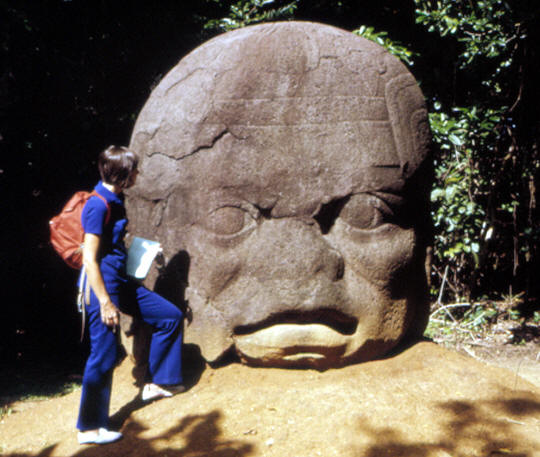
IMAGE FROM LITHIC CASTING LAB'S COLLECTION OF ORIGINAL IMAGES
CLICK ON PICTURE FOR LARGER IMAGE
COLOSSAL HEAD
OLMEC CULTURE
LA VENTA SITE
TABASCO, MEXICO
This colossal
head is designated as monument 4. It was discovered in 1939 by Mathew Sterling on the La Venta site in
Tabasco. Both ears are missing but one side still displays an earspool
in the form of a rounded square with a cross motif. There are also teeth
present within the shadow of the mouth. The top center of the headdress
is decorated with the clawed foot of a bird of prey. Both ears are
eroded away and there is also damage to a portion of the "helmet" and
some of the mouth. Stirling wrote about the damage in 1940: "Like some
battle scared veteran, this one has lost most of his jaw and his nose
has been flattened, probably the work of enemies who deliberately tried
to destroy all evidence of this ancient culture long before the white
man came to America." This colossal head is made of basalt and measures 7.41 feet (2.26 m) high
and weighs 19.8 tons. |
|
|
Olmec colossal heads were made with simple stone tools in
very much the same way a common axe was made by pecking and grinding,
but only on a much larger scale. The surfaces were shaped with stone
hammers and smoothed by grinding. The people on Easter Island made their
large moai statues in the same way. Neither culture had metal tools. |
|
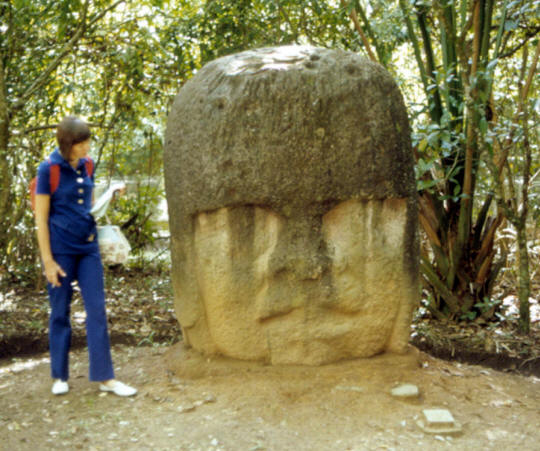
IMAGE FROM LITHIC CASTING LAB'S COLLECTION OF ORIGINAL IMAGES
CLICK ON PICTURE FOR LARGER IMAGE
COLOSSAL HEAD
OLMEC CULTURE
LA VENTA SITE
TABASCO, MEXICO
This colossal head is designated as monument 3. It's surface is
heavily eroded and it has the appearance of being unfinished. It
does have a large headdress with straps that extend down in front of
the ears. The ears are decorated with large rings that overlap the
straps. This colossal head is made of basalt and measures 6.49 feet (1.98 m)
high and weighs 12.8 tons. |
|
|
Most of the colossal heads have flattened backs. In fact,
only four of them do not. It's been suggested that many of the colossal
heads were made from reworked monumental thrones. Two examples from San
Lorenzo have evidence of niches that indicate they were made from
reworked thrones. |
|
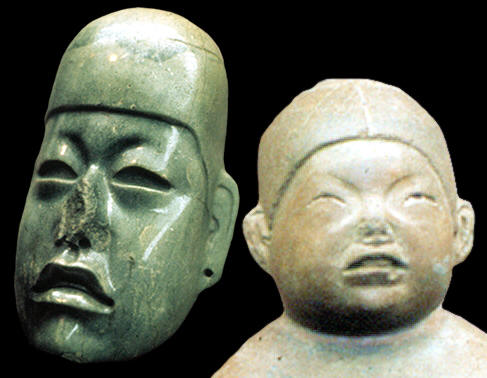
IMAGE FROM LITHIC CASTING LAB'S COLLECTION OF ORIGINAL IMAGES
JADE FIGURES
OLMEC CULTURE
These Olmec jade sculptures illustrate some of the unique style of
Olmec portraiture art. Both have the "classic" helmet-like head
covering and eyes that seem to suggest an Asian influence. The
elongated head suggests cranial deformation by reshaping an infants
skull with binding. The figure on the left also has one of the
"classic" mouth styles with highly curved thick lips with down
turned corners. |
|
|
Many of the large Olmec monuments were prehistorically
damaged. Although some did survived in very good condition, like the San
Lorenzo colossal head monument 4, a good percentage of Olmec monuments
are cracked, and pieces broken away in what archaeologists refer to as
mutilated. Sterling wrote in 1940 about his excavations at La Venta:
"Almost all of the great stone alters (thrones)
and monuments have been broken and mutilated at the cost of considerable
effort. This could not have happened by accident." |
|
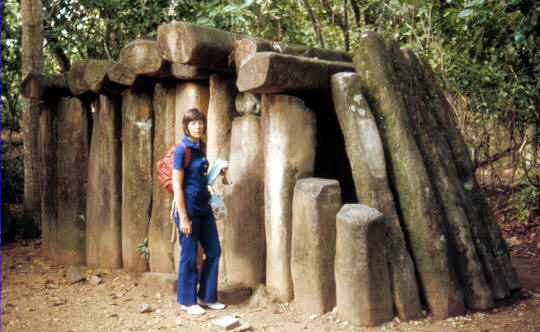
IMAGE FROM LITHIC CASTING LAB'S COLLECTION OF ORIGINAL IMAGES
BASALT COLUMN TOMB
OLMEC CULTURE
LA VENTA SITE, TOMB A
TABASCO, MEXICO
This impressive tomb
structure was removed from Mound A-2 on the La Venta site and
reconstructed on the surface. The walls and roof were made from basalt
columns that were carved to look like logs and the floor was made of
flat limestone slabs. The tomb contained the remains of two juveniles
and offerings of fine jade figurines, beads, a jade pendant in the shape
of a clam shell and other objects. |
|
|
One of the most controversial issue that is often discussed
about the colossal heads are the facial features that appear to be
African. But the majority of academic scholars reject this possibility.
It's believed the features may be more Asian than African. In addition
to the broad noses and thick lips some writers add the Asian eye fold
and straight hair that can be observed on naturalistic Olmec sculptures.
All of these traits can be observed in modern society Native American
Indians in the region today. DNA analysis has also not shown any
evidence of an African connection. There is also no evidence of imports from Africa,
such as, plants, animals, materials or techniques. |
|
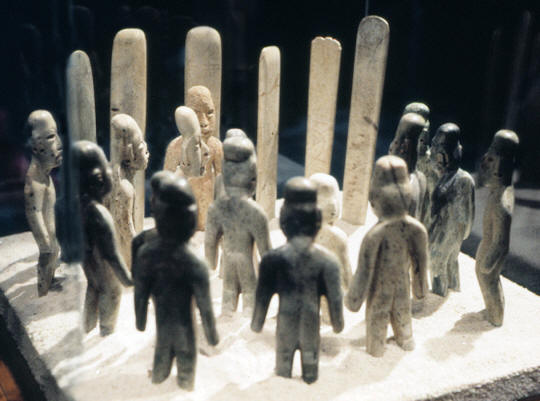
IMAGE FROM LITHIC CASTING LAB'S COLLECTION OF ORIGINAL IMAGES
GROUP OF STANDING FIGURES &
CELTS
GRANITE, JADEITE & SERPENTINE
OLMEC CULTURE
LA VENTA SITE
TABASCO, MEXICO
The
Olmec culture also produced large numbers of finely crafted small
stone objects in the form of celts, figurines, jewelry, etc. This
picture shows the famous offering 4 that was discovered in 1955 at
La Venta. It's been described as "one of the most extraordinary
discoveries in the Gulf Coast heartland---." The group of sixteen
figures and six celts were discovered during the excavation of one
of the three platform mounds within the enclosed court of complex A.
The cache was positioned in front of the northeast platform mound.
One figure stands with his back to a row of upright celts that
represent miniature engraved stelae. The group of figures may represent some
type of ceremonial stela ritual. Thirteen of the figures are made of
serpentine, two are made of jadeite and the figure with his back to
the celts and facing the other fifteen figures is made of granite. |
|
|
For thousands of years people around the world have marveled
at, prayed to, and even feared colossal statues carved in stone. Even
today, the giant heads laying helter-skelter on top of Mount Nemrut in
Turkey, the giant monuments of Ramsey in Egypt, Easter Island moai, or
the 233 foot tall Leshan giant Buddha in China, still project a feeling of
strength and power. Just as the colossal heads of the Olmec still do
today. |
|
"REFERENCES"
1940,
Stirling, Matthew W., "Great Stone Faces Of The Mexican Jungle,"
National Geographic, September 1940, pp. 309-334.
1993, Stuart, George E., "New Light
On The Olmec," National
Geographic, November 1993 p. 94.
1994, Coe, Michael D., "Mexico, From The Olmec To The Aztecs," p.
66.
1995, Coe, Michael D., Diehl, Freidel, Furst, Reilly III,
Schele, Tate, & Taube, "The Olmec World Ritual And Rulership."
1996, Brian M. Fagan, "The Oxford Companion To Archaeology," p. 538.
2010, Reyes, Roberto Lunagomez, "Plates," Olmec, Colossal
Masterworks Of Ancient Mexico,
p. 122.
2010, Susan Toby Evans and David L. Webster, "Archaeology Of Ancient
Mexico And Central America An Encyclopedia," p. 34.
Personal Communications with, Dennis Vesper.
|
|
RECENT
LISTINGS HOME
ORDERING |